
Final Fantasy Adventure, known in Japan as Seiken Densetsu: Final Fantasy Gaiden or simply Seiken Densetsu, and later released in Europe as Mystic Quest, is an action role-playing video game developed and published by Square for the Game Boy. It is a spin-off of the Final Fantasy series and the first game in the Mana series. It was re-released by Sunsoft in April 1998.

The Mana series, known in Japan as Seiken Densetsu, is a high fantasy action role-playing game series created by Koichi Ishii, with development formerly from Square, and is currently owned by Square Enix. The series began in 1991 as Final Fantasy Adventure, a Game Boy handheld side story to Square's flagship franchise Final Fantasy. The Final Fantasy elements were subsequently dropped starting with the second installment, Secret of Mana, in order to become its own series. It has grown to include games of various genres within the fictional world of Mana, with recurring stories involving a world tree, its associated holy sword, and the fight against forces that would steal their power. Several character designs, creatures, and musical themes reappear frequently.

Secret of Mana, originally released in Japan as Seiken Densetsu 2, is a 1993 action role-playing game developed and published by Square for the Super Nintendo Entertainment System. It is the sequel to the 1991 game Seiken Densetsu, released in North America as Final Fantasy Adventure and in Europe as Mystic Quest, and it was the first Seiken Densetsu title to be marketed as part of the Mana series rather than the Final Fantasy series. Set in a high fantasy universe, the game follows three heroes as they attempt to prevent an empire from conquering the world with the power of an ancient flying fortress.
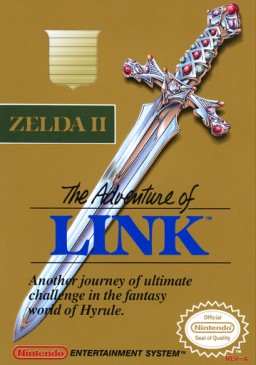
Zelda II: The Adventure of Link is an action role-playing video game with platforming elements developed and published by Nintendo. It is the second installment in the Legend of Zelda series and was released in Japan for the Famicom Disk System on January 14, 1987—less than one year after the Japanese release and seven months before the North American release of the original The Legend of Zelda. Zelda II was released in North America and the PAL region for the Nintendo Entertainment System in late 1988, almost two years after its initial release in Japan.
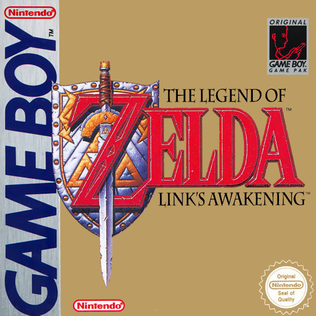
The Legend of Zelda: Link's Awakening is a 1993 action-adventure game developed and published by Nintendo for the Game Boy. It is the first installment in The Legend of Zelda series for a handheld game console. Link's Awakening is one of the few Zelda games not to take place in the land of Hyrule, and it does not feature Princess Zelda or the Triforce relic. Instead, the protagonist Link begins the game stranded on Koholint Island, a place guarded by a whale-like deity called the Wind Fish. Assuming the role of Link, the player fights monsters and solves puzzles while searching for eight musical instruments that will awaken the sleeping Wind Fish and allow him to escape from the island.
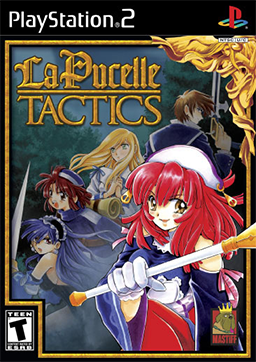
La Pucelle: Tactics is a tactical role-playing game developed by Nippon Ichi Software for the PlayStation 2. It was released in Japan in January 2002, and in North America by Mastiff in May 2004. The game was ported to the PlayStation Portable in Japan on November 26, 2009 as La Pucelle Ragnarok. The Ragnarok version would later be ported to Windows and Nintendo Switch as part of the NIS Classics Volume 3 on August 30, 2022 in America, September 2, 2022 in Europe, and September 9, 2022 in Australia and New Zealand.

Ogre Battle: The March of the Black Queen is a 1993 real-time tactical role-playing game developed by Quest Corporation. Originally published for Super Nintendo Entertainment System by Quest in Japan and by Enix America in North America. It is the first installment of the Ogre Battle series. It was directed by Yasumi Matsuno, and designed by Matsuno with Akihiko Yoshida. The story of Ogre Battle focuses on a band of rebels as they lead a revolution against a corrupt reigning Empire, ruled by an evil Empress.

Wizards & Warriors, titled Densetsu no Kishi Elrond in Japan, is an action platform video game developed by Rare and published by Acclaim Entertainment and Jaleco for the Nintendo Entertainment System. It was released in North America in December 1987, and in Europe on January 7, 1990. The player controls Kuros, "Knight Warrior of the Books of Excalibur", as he sets out in the Kingdom of Elrond to defeat the evil wizard Malkil. Malkil holds the princess of Elrond captive in Castle IronSpire, deep within the forests of Elrond. The player fights through forests, tunnels, and caves, while collecting keys, treasure, weapons, and magic items.

The Legend of Kage is a side-scrolling hack-and-slash game developed and published by Taito in 1985. In this game, the player controls the ninja Kage, with the objective being to get through five stages in order to save the pincess Kirihime. These stages are littered with enemies, however Kage has various skills and weapons on his hands in order to get through them.
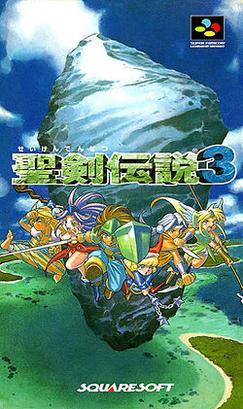
Trials of Mana, also known by its Japanese title Seiken Densetsu 3, is a 1995 action role-playing game developed and published by Square for the Super Famicom. It is the sequel to the 1993 game Secret of Mana, and is the third installment in the Mana series. Set in a high fantasy world, the game follows three heroes as they attempt to claim the legendary Mana Sword and prevent the Benevodons from being unleashed and destroying the world. It features three main plotlines and six different possible main characters, each with their own storylines, and allows two players to play simultaneously. Trials of Mana builds on the gameplay of its predecessor with multiple enhancements, including the use of a time progression system with transitions from day to night and weekday to weekday in game time, and a wide range of character classes to choose from, which provides each character with an exclusive set of skills and status progression.
LCD games are electronic games played on an LCD screen. Since the release of the Zelda Game & Watch game in August 1989, several LCD games based upon the theme of The Legend of Zelda have been licensed by Nintendo to be released for both Japanese and foreign markets. While Zelda was both developed and manufactured by Nintendo, later LCD games would only be licensed by Nintendo. The Legend of Zelda game watch is an LCD wristwatch game produced by Nelsonic as part of their Nelsonic Game Watch series, and Zelda no Densetsu: Kamigami no Triforce is an LCD fighting video game licensed by Nintendo and produced by Epoch Co. for the Barcode Battler II platform, and released only in Japan.

Fatal Fury 2, known as Garō Densetsu 2: Aratanaru Tatakai in Japan, is a 1992 fighting video game released by SNK for the Neo Geo arcade and home platforms, and later ported to several other home systems. It is the sequel to Fatal Fury: King of Fighters (1991) and the second game in the Fatal Fury franchise. Its updated version, Fatal Fury Special, was released in 1993.
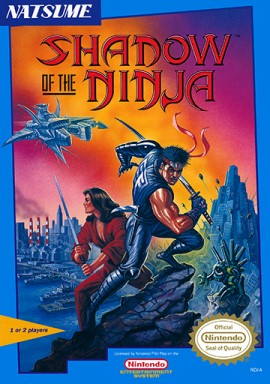
Shadow of the Ninja, originally released in Japan as Yami no Shigotonin Kage and later released in Europe and Australia as Blue Shadow, is a side-scrolling action game developed by Natsume Co., Ltd. for the Nintendo Entertainment System (NES) in 1990. The game revolves around a pair of ninja sent to assassinate a dictator in a futuristic version of New York City. A port was planned for the Game Boy, but was released in a rebranded form as Ninja Gaiden Shadow.
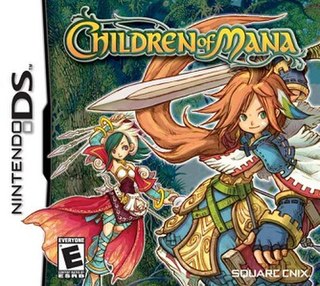
Children of Mana is a 2006 action role-playing game for the Nintendo DS handheld console. It was developed by Square Enix and Nex Entertainment, and published by Square Enix and Nintendo. It is the sixth game of the Mana series—following 2003's Sword of Mana—and the first entry in the World of Mana subseries. Set in a high fantasy universe, Children of Mana follows one of four young heroes as they combat an invasion of monsters and learn about the cataclysmic event that killed their families.
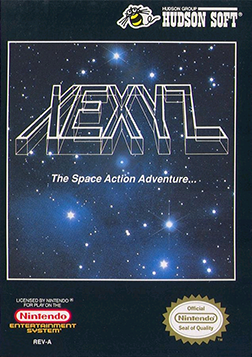
Xexyz, known in Japan as Kame no Ongaeshi - Urashima Densetsu, is a 1988 video game published by Hudson Soft for the Nintendo Entertainment System. The game was released in Japan on August 26, 1988, and saw a North American release sometime in April 1990. The game was never released in Europe and the game is not playable on PAL consoles.

Fist of the North Star is a side-scrolling action video game produced by Toei Animation and developed by Shouei System for the Nintendo Entertainment System (NES). It was first released in Japan under the title Hokuto no Ken 2 on April 17, 1987, being the second Hokuto no Ken video game released for the Family Computer (Famicom) by the anime production company, while also serving as a tie-in to the Hokuto no Ken 2 anime series which began airing on Fuji TV a few weeks earlier. Taxan published the localized NES version in April 1989, making it one of the earliest Fist of the North Star products released in the U.S. alongside Viz Communications' English adaptation of the manga.
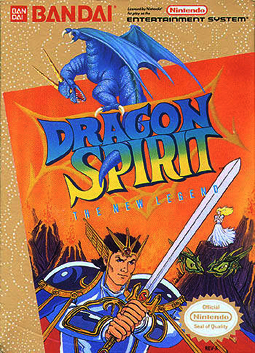
Dragon Spirit: The New Legend is a shoot 'em-up video game developed by Now Production and published by Namco in Japan and Bandai worldwide for the Nintendo Entertainment System in 1989. It is a remixed port of the 1987 arcade game Dragon Spirit.
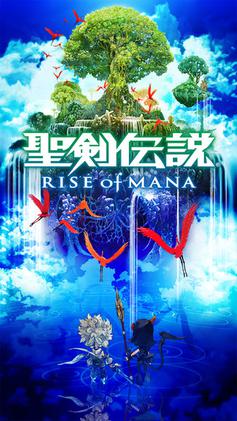
Rise of Mana is a Japanese action role-playing video game developed by Goshow for iOS, Android and PlayStation Vita. It was published by series creator Square Enix in 2014 for mobile devices and 2015 for the Vita. It is the eleventh game in the Mana series, featuring a new narrative unconnected to other games in the series. The gameplay uses a similar action-based battle system to earlier Mana titles while using a free-to-play model in common with mobile titles. The story focuses on two characters, an angel and a demon, who are cast down to the mortal world in the midst of a battle and are forced to share a body in order to survive.

Adventures of Mana is an action role-playing video game developed by MCF and Square Enix, and published by Square Enix. It is a 3D remake of the 1991 Game Boy game Final Fantasy Adventure, the first game in the Mana series. It was released worldwide for Android and iOS on February 4, 2016; a PlayStation Vita version was also released on the same date in Japan, and in June 2016 in North America, South America and Europe. In addition to these releases, Square Enix has said that they are considering developing versions for PlayStation 4 and personal computers.

Trials of Mana is a 2020 action role-playing game developed by Xeen and published by Square Enix for Nintendo Switch, PlayStation 4 and Windows. A mobile port released the following year. It is a 3D remake of the 1995 Super Famicom title of the same name, the third game in the Mana series. The story follows six possible protagonists in their respective quests, which lead them to obtain the Mana Sword and fight a world-ending threat. In gameplay, the player controls three out of six characters, navigating field environments, fighting enemies in real-time combat, and making use of character classes. New to the gameplay and storyline is a post-game chapter with an unlockable class.




















